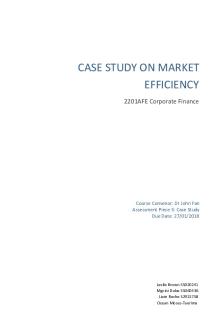Whole Foods Market Case Study Notes PDF

| Title | Whole Foods Market Case Study Notes |
|---|---|
| Course | Cases In Financial Management |
| Institution | Virginia Commonwealth University |
| Pages | 2 |
| File Size | 78.2 KB |
| File Type | |
| Total Downloads | 92 |
| Total Views | 145 |
Summary
whole foods case study notes for fire cases class...
Description
Whole Foods Market
May 26, 2014 o $0.38 per share in quarterly earnings report (Wall Street consensus 0.41) o Share price fell to $38.93 o Increase quarterly dividend from .10 to .20 (20%) o Is Whole Foods successful?
The Grocery Industry -
-
-
-
Low-growth industry bc of fierce competition 2012 – industry $600 billion in sales Demand growth tied to population growth Estimated nominal long-term growth ~2-3% o Kroger, Publix, Safeway, Albertsons o Wal-Mart, Fresh Market, Costco and Sam’s Club Walmart – largest food retailer in 2014 – 25% market share Narrow margins & limited growth opportunities favored large competitors Small competitors were forced to close Loyalty programs, store experience, self-checkout Promoting prepared foods Private-label products – low prices while capturing margins Natural grocers grown rapidly o Helth-conscious customers o Over 20% per year growth since 1990 o 2012 – natural/organic products = $81billion in sales 19-29-year-old population Whole foods, sprouts, fresh market Whole Foods – position as market leader for natural and organic industry o System to rate fresh produce o Website list of prohibited substances in its products o Labeled genetically modified foods Criticism on nutrition benefits of organic foods
Whole Foods Market -
1978 First natural and organic supermarkets Texas Louisiana California Canada – UK “Whole Paycheck” – premium products
Research Report -
Bears perspective: natural/organic market becoming saturated from other companies offering same product at lower costs o Disspointing quarterly reports o 3 miles from Trader Joes o WF – running out of dense, educated, high-income areas
-
-
o Compoetion - lead of revaluate Whole Foods Bulls: believed WF leadership in organic, shifting preferences and organic growth should sustain EF growth o Well positioned o Leader for organic industry o Opportunity to reduce operating expenses Offset decline in revenue o Take into consideration into lower-income areas - private label products may offer similar, high quality products at better price -CEO John Mackey o WF was best-industry o No competitor offered the quality products that WF could o investments to improve customer experience Shorter wait times High quality self-service food...
Similar Free PDFs

Case Whole Foods Market Inc 2009
- 18 Pages

Whole Foods Notes
- 13 Pages

Whole foods case study real-2
- 8 Pages

Case 1: Kraft Foods Case Study
- 5 Pages

CASE STUDY ON MARKET EFFICIENCY
- 13 Pages

Diamond Foods CASE Analysis
- 4 Pages

Case study final 2 - Smith\'s market
- 13 Pages

CLT - Whole Course Notes
- 42 Pages

HESI Case Study Notes
- 20 Pages
Popular Institutions
- Tinajero National High School - Annex
- Politeknik Caltex Riau
- Yokohama City University
- SGT University
- University of Al-Qadisiyah
- Divine Word College of Vigan
- Techniek College Rotterdam
- Universidade de Santiago
- Universiti Teknologi MARA Cawangan Johor Kampus Pasir Gudang
- Poltekkes Kemenkes Yogyakarta
- Baguio City National High School
- Colegio san marcos
- preparatoria uno
- Centro de Bachillerato Tecnológico Industrial y de Servicios No. 107
- Dalian Maritime University
- Quang Trung Secondary School
- Colegio Tecnológico en Informática
- Corporación Regional de Educación Superior
- Grupo CEDVA
- Dar Al Uloom University
- Centro de Estudios Preuniversitarios de la Universidad Nacional de Ingeniería
- 上智大学
- Aakash International School, Nuna Majara
- San Felipe Neri Catholic School
- Kang Chiao International School - New Taipei City
- Misamis Occidental National High School
- Institución Educativa Escuela Normal Juan Ladrilleros
- Kolehiyo ng Pantukan
- Batanes State College
- Instituto Continental
- Sekolah Menengah Kejuruan Kesehatan Kaltara (Tarakan)
- Colegio de La Inmaculada Concepcion - Cebu






